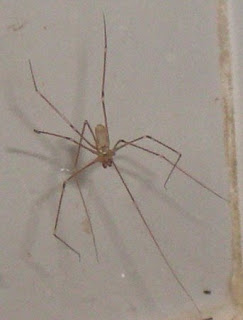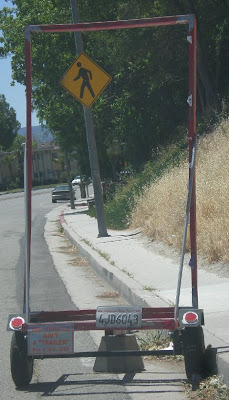 This California pepper tree (Schinus molle) is a volunteer in my garden. Less than two years old, it is already more than ten feet tall. Originally it had two main branches veeing away from the base, but one was damaged by winter storms and had to be cut away. The tree now has about half the volume it would otherwise have had.
This California pepper tree (Schinus molle) is a volunteer in my garden. Less than two years old, it is already more than ten feet tall. Originally it had two main branches veeing away from the base, but one was damaged by winter storms and had to be cut away. The tree now has about half the volume it would otherwise have had.I'm very fond of pepper trees, but I have mixed feelings about this one. It's not in a spot where a really large tree would be appropriate. Pepper trees are fast growers and can reach 30-40 feet high with a spread to match. Of, course, we can keep it under control (we think) with careful pruning.
Despite the name, these trees aren't really native to California. (Hint: They are also known as the Peruvian pepper tree.) They were brought here from South America by Spanish missionaries a few hundred years ago. They are now naturalized, although I have occasionally seen them classified as invasive, or even as weeds. Drought-resistant, they provide excellent shade, the Spaniards' motive for carrying them so far. Although apparently some people use the "peppers" (small pink fruits that grow in clusters in the fall) to flavor food, it's not a good idea, as they are toxic in quantity.
 The green bins are for yard trimmings. The blue bins are for recyclable items. The black bins are for (non toxic) trash. This system has been in place for many years. So when our neighbors, Mr. and Mrs. Loud,* stuffed their green and blue bins full of old carpeting, they were the only ones to be surprised that the bins weren't emptied. "I didn't know," Mrs. L claimed later that morning. Luckily for her, the truck handling black bins had not yet arrived. So she waited by the bins, told the driver of the trash truck she had made a "mistake", and got him to empty these. It's a good thing, too, because the Louds' excess trash has a way of mysteriously appearing in other people's bins in the middle of the night.
The green bins are for yard trimmings. The blue bins are for recyclable items. The black bins are for (non toxic) trash. This system has been in place for many years. So when our neighbors, Mr. and Mrs. Loud,* stuffed their green and blue bins full of old carpeting, they were the only ones to be surprised that the bins weren't emptied. "I didn't know," Mrs. L claimed later that morning. Luckily for her, the truck handling black bins had not yet arrived. So she waited by the bins, told the driver of the trash truck she had made a "mistake", and got him to empty these. It's a good thing, too, because the Louds' excess trash has a way of mysteriously appearing in other people's bins in the middle of the night. I photographed these daddy long-legs spiders (
I photographed these daddy long-legs spiders ( Usually found in or around houses, the daddy long-legs is sometimes also called the cellar spider. (It is occasionally confused with a couple of other species that are also sometimes called long-legs or daddy long-legs.) They like to hang upside down from their webs and wait for prey. They eat small insects and spiders. When food is short, they will eat their own kind.
Usually found in or around houses, the daddy long-legs is sometimes also called the cellar spider. (It is occasionally confused with a couple of other species that are also sometimes called long-legs or daddy long-legs.) They like to hang upside down from their webs and wait for prey. They eat small insects and spiders. When food is short, they will eat their own kind.
 Last night someone informed me that the
Last night someone informed me that the